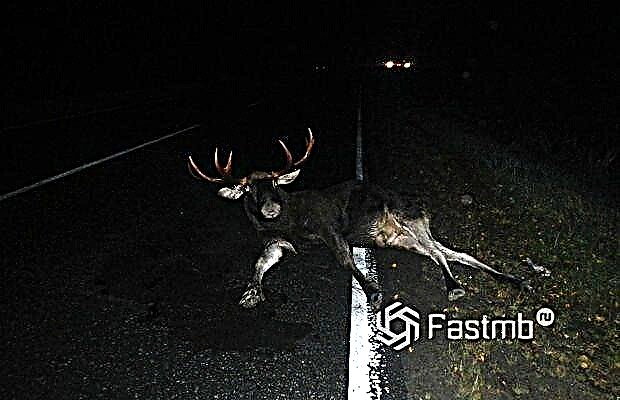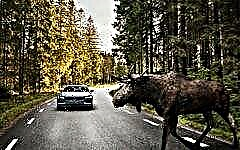

The content of the article:
- System nuances
- Device
- Principle of operation
- Advantages and disadvantages
Large Animal Detection System is an intelligent electronic mechanism capable of detecting, recognizing and warning the driver of large animals on the road, as well as a possible collision. For countries with massive loess plantations, this system has become standard in the vehicle, and in some regions it has become mandatory.
Today it is practically impossible to meet a modern car without an active or passive safety system. For many manufacturers, this has become a standard and basis, further improving the safety of the machine. In our case, the large animal detection system not only allows you to avoid collisions, warn the driver in time, but also stabilize the movement of the car after avoiding a collision. Let's consider in more detail the device and the principle of operation of the mechanism.
What is an animal detection system

Large animal detection systems - LADS (Large Animal Detection System) or RADS (Roadway Animal Detection System) are most often found on cars in countries with forested areas. The main task of the mechanism is to identify large animals (deer, elk, horse, cow, etc.). As for the smaller animals (roe deer, dog, wild boar), the system does not recognize them. According to statistics, about 6% of road traffic accidents are caused by wild animals. Even an experienced driver is not always able to react in time to an accidentally appeared obstacle on the road.
Most often, the large animal detection system is found on Volvo cars, but does not exclude other cars. Scandinavia is simply overcrowded with animals of this size and accidents involving large animals are common in these latitudes. One can only imagine what consequences await the car, passengers and driver after a collision with an elk or a deer. In addition to Scandinavia, Canada, the USA, Russia and Australia are also included in the list of countries. As for the mechanism itself, it is more of a software logic that parasitizes on other active security systems than a separate mechanical unit. Only large animals are recognized for safety reasons, because in such an area there are even more small animals, respectively, the car will react to the smallest movement, and the trip will turn into an obstacle course.
How the large animal detection system works

As already mentioned, other active safety mechanisms served as the basis for the large animal detection system. The main device is software, which, due to specially formed logic, fulfills the assigned tasks. Often the basis is pedestrian recognition and cyclist warning systems.
The principle of operation of the LADS system

As a rule, the analysis is carried out on large moving objects. It is worth noting that the system cannot recognize all representatives of the fauna, so you should not rely 100% on the logic of the algorithm. That is why individuals comparable to the size of an adult moose are recognized, everything that is smaller can recognize 50/50.

In case of recognition of a large animal, the system immediately gives a sound signal to the driver. If the driver does not show any reaction and continues driving, the system activates emergency braking, thereby avoiding the collision. In addition to recognizing and braking, this mechanism works out its functions after a maneuver. Imagine a situation when an elk ran out onto the road, and the driver managed to avoid a collision by making a maneuver. Avoiding a collision is only 50% of success, then the car should be returned to its previous trajectory. The Large Animal Detection system uses stabilization, lane keeping, and other systems to help the driver align the vehicle. It is worth noting that the efficiency of detecting large animals will be only at low speed and in compliance with all the rules of movement. In the case when the car was moving quickly, the system minimizes the consequences of a collision, but there is no 100% guarantee to avoid an accident.
Pros and cons of the LADS system

Like any other mechanism, the LADS detection system has its pros and cons. The advantages of this mechanism are that a person simply cannot keep track of the situation on the road, especially if the area is not familiar, and even more so, the behavior of animals cannot be predicted in any way. In fact, this is an assistant who, together with the driver, monitors the situation on the road, the only difference is that he does not get tired and there can be two options - he recognized it or not.
If the plus of the system is clear, then what is the minus. The main disadvantage is that the system only recognizes large animals that match the pattern. Accordingly, the right to error is not excluded, and therefore the situation with an accident, which cannot be avoided. Also, do not forget that the last decision remains with the driver.

In Canada and individual states of North America, engineers took a different path. Realizing that not all cars can be equipped with a large animal detection system, it was made stationary by installing it on the side of the road. Sensors scan the forest belt, in case of detection of animals (both large and small animals can be detected), a flashing beacon is activated.
Thus, the system informs passing drivers about the presence of animals in the forest belt, and hence the situation of a collision with them. The LADS detection system is an essential assistant for the driver in forest areas. According to the owners, it repeatedly saved from collisions with animals, thereby saving the lives of passengers and without damaging the car.











